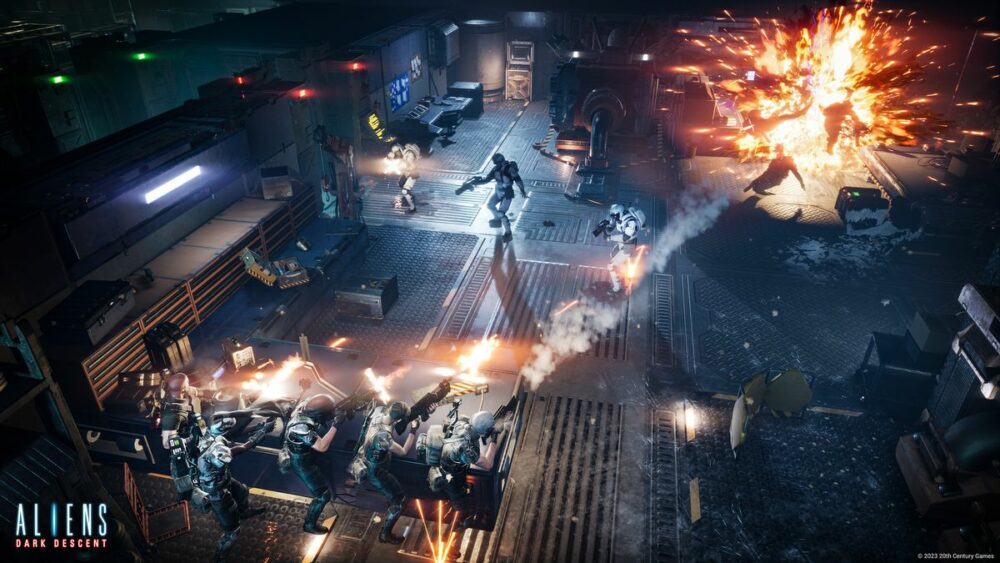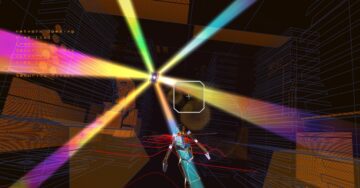Aliens: Dark Descent is billed as a real-time action game, carefully skirting the real-time strategy classification. This new classification is not a gimmick. Tindalos Interactive has produced a tense single-player experience that flirts with several disparate genre traits, while clearly providing a singular and ambitious approach. However, much like the divisive Alien franchise film Prometheus, its experimentation struggles to maintain creative momentum throughout.
Dark Descent entirely strips or purposefully narrows the aspects of resource gathering, technological improvement, and base building found in many RTS titles. There’s no real-time macro layer to speak of, with the moment-to-moment focus on the micro actions of maneuvering your team of four USMC soldiers. It’s akin to StarCraft campaign missions where you’re exploring with just a handful of Terran marines. This spotlights the tension around specific named characters and their survival: Instead of ore and minerals, you’re worried about ammo and stress. And when one of your grunts is slaughtered — or worse, carried away by an Alien drone to be impregnated — it fosters grief and regret. This is a brutal game of moments that stick with you.
You’re eased into this framework with a 45-minute tutorial, which also functions as a prologue to the greater story. This prolonged intro is welcome, as there are some quirks to the systems at play, and you need to come to grips with the unusual tactical options they present.
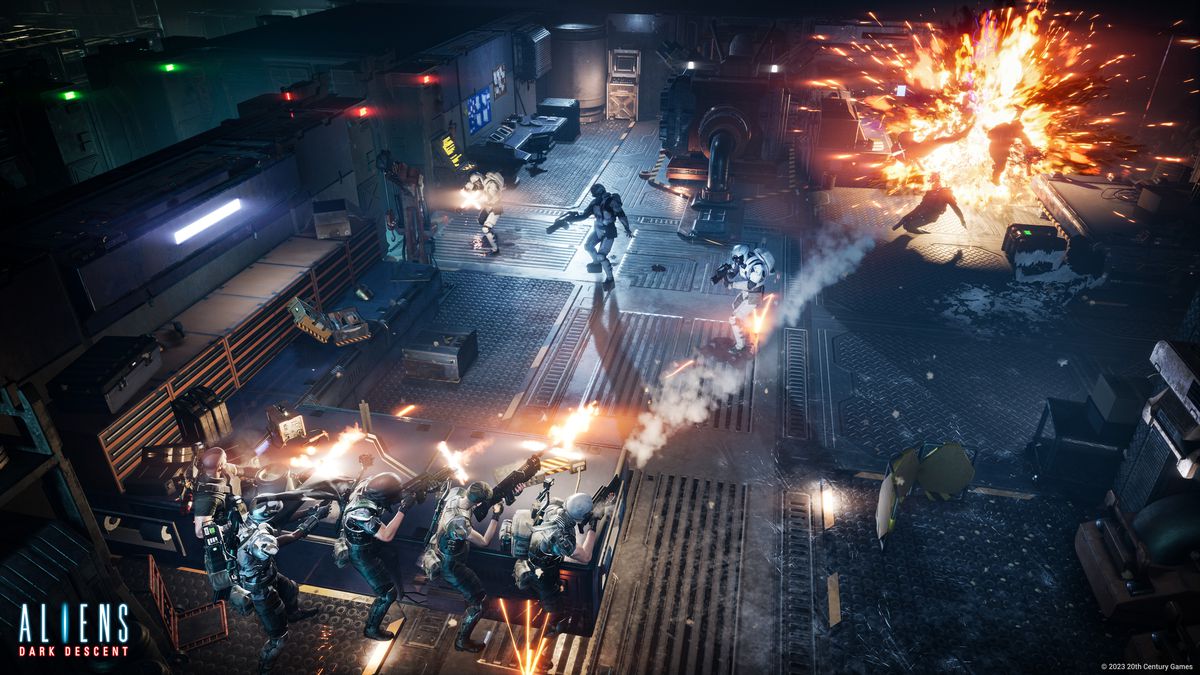
The most sophisticated of those tactical systems are focused around command points. You spend this resource to lay down cones of suppressive fire, deliver powerful short-range shotgun blasts, and spit walls of fire to protect your position. You can never pause the game, only resorting to slow motion when you open the command menu. It’s imperative you attain comfort with this system quickly, as it’s the heart of tactical decision making during the high-intensity conflict.
But this tutorial is also Dark Descent at its most mundane. The action sequences are dull, offering few interesting tactical decisions or opportunities for creativity. It flirts with danger in not attempting to hook a new player, failing to highlight the game’s strengths or entertaining cinematic combat. This prefaces a similarly rote storyline, which begins with a Weyland-Yutani corporate plot complete with a disturbing synthetic human. There are moments later in the campaign which similarly slip into predictability, and it’s in these stages where the game threatens to loosen its grip on your attention.
Much of the intrigue arises from the various subsystems that compose the texture of the combat. The actual clicking around and maneuvering is somewhat uninspiring. What’s more, you can’t send a solitary trooper or smaller fireteam to defend a position or perform a flanking maneuver; the squad is forced to stick together. This keeps the action streamlined, but it also saps some of the tactical depth. Additionally, this can make for some repetition in sequences, as you repeatedly try to maintain long narrow sightlines to force approaching hordes through bottlenecks under your withering fire. It does manage to keep things satisfyingly simple, though. The different environments are rich and fully realized in scope and vision. You get to travel through sprawling colonies and massive space docks with entire sections encased in a xenomorph shell. All of this is also enhanced strongly by the roster administration and open-world aspects of play. It’s in these periods of tentative, heavily armed exploration where Dark Descent really takes off.
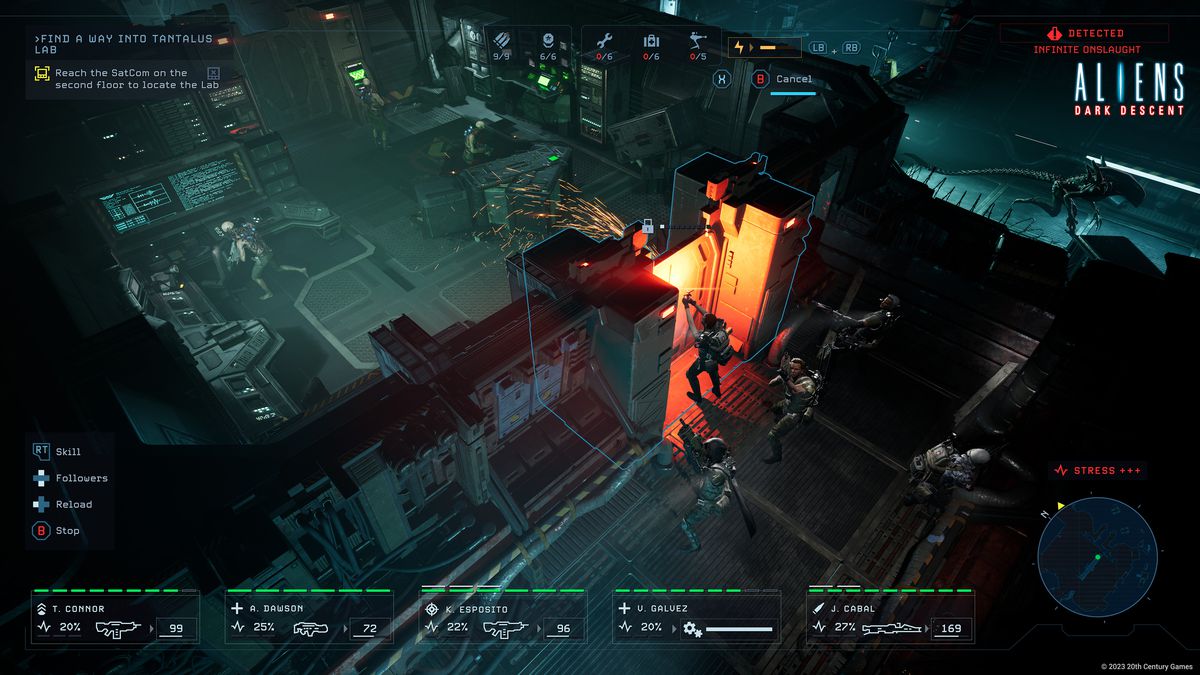
There are also moments of beauty and inventiveness. While you are traversing massive sectors with both interior and exterior combat zones, you’re unexpectedly swarmed by xenomorphs of all shapes and sizes. The AI adapts to your tactics, maneuvering around defensive vectors such as sentry guns and walls of flame. You have to contend with facehuggers and acid blood, and it feels as though you’re actually being hunted. Even the environment itself will occasionally turn against you, forcing your soldiers to confront their mental trauma by sealing themselves inside rooms with welding torches.
Between missions, you research new gear and unlock skills with your various troopers. pouring experience and resources back into your barracks. This layer, clearly inspired by Firaxis’ XCOM games, creates a wonderful loop of steadily increasing your soldiers’ potency only to make them an even juicier target for the xenomorphs. It’s sharp and memorable, and it leads to some great emergent storytelling moments.
Where Dark Descent pushes beyond XCOM is in mission selection. The campaign is somewhat linear, but it achieves an open-world feel by allowing you to uncover new areas of the world map — various settlements and installations on the planet Lethe, which is undergoing a global crisis. While it’s required that you complete the main story objectives in each sector, you can also return to each one to scrounge up missing items and complete sub-tasks at a later time. Dark Descent’s structure even allows you to evacuate mid-mission, preserving the mental and physical health of your squad members after it all goes sideways. I’ve had extreme moments of highs and lows, as I’ve evacuated multiple times when pursuing certain objectives, salvaging what I could and placing my squad in the med-bay before re-deploying with new roster members. Do this too often, and the alien threat will intensify over time. This creates an illusion of a persistent environment, one that’s evolving of its own autonomy.
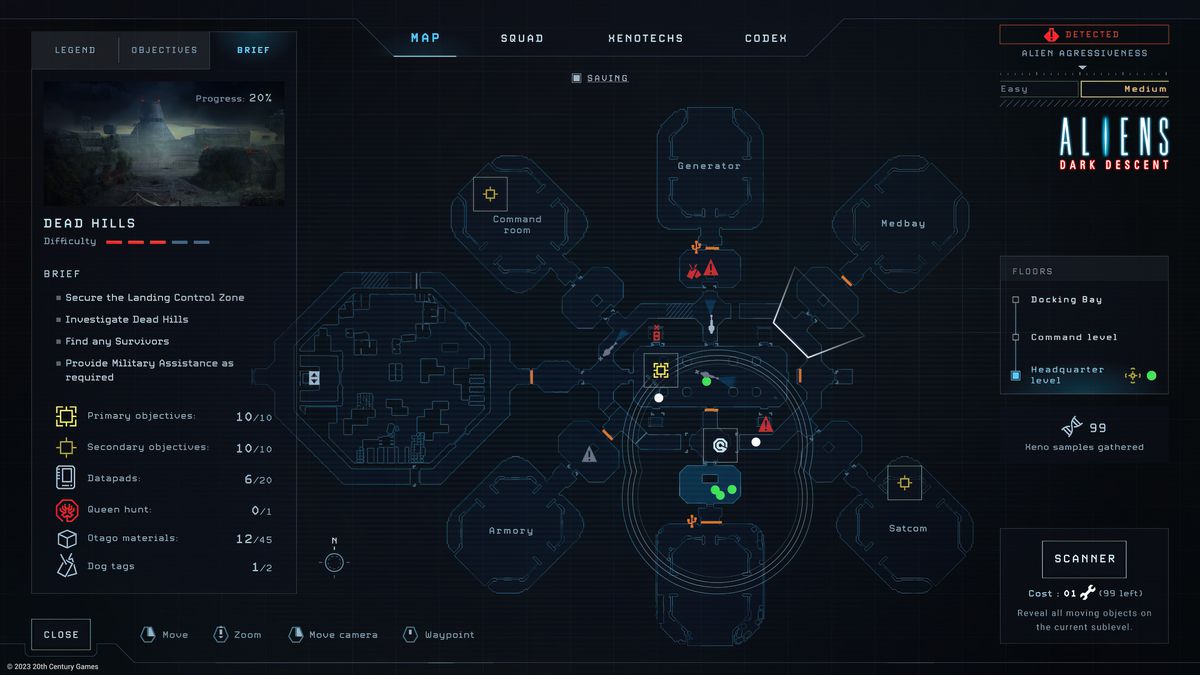
Aliens: Dark Descent is at times ambitious, often to delight, but occasionally to indiscretion. While some may desire a more intimate and terrifying Alien Isolation sequel, this isometric tactical challenge is rich in consequence and reward. This may not be the most coherent or exceptional Alien video game we’ve seen, but it’s certainly noteworthy and imaginative.
Aliens: Dark Descent is available now for PlayStation 4, PlayStation 5, Windows PC, Xbox One, and Xbox Series X. The game was reviewed using a retail copy provided by Focus Home Interactive. Vox Media has affiliate partnerships. These do not influence editorial content, though Vox Media may earn commissions for products purchased via affiliate links. You can find additional information about Polygon’s ethics policy here.
- SEO Powered Content & PR Distribution. Get Amplified Today.
- PlatoData.Network Vertical Generative Ai. Empower Yourself. Access Here.
- PlatoAiStream. Web3 Intelligence. Knowledge Amplified. Access Here.
- PlatoESG. Automotive / EVs, Carbon, CleanTech, Energy, Environment, Solar, Waste Management. Access Here.
- BlockOffsets. Modernizing Environmental Offset Ownership. Access Here.
- Source: https://www.polygon.com/reviews/23769830/aliens-dark-descent-review
- a
- About
- Achieves
- Action
- actual
- actually
- adapts
- Additionally
- administration
- Affiliate
- after
- Against
- AI
- alien
- Aliens
- All
- Allowing
- allows
- along
- also
- ambitious
- an
- and
- approach
- approaching
- ARE
- areas
- armed
- around
- as
- aspects
- At
- attain
- attention
- available
- away
- back
- base
- BE
- Beauty
- before
- behind
- being
- beyond
- blood
- both
- Building
- but
- by
- Campaign
- CAN
- carefully
- carried
- certain
- certainly
- challenge
- characters
- cinematic
- classification
- clearly
- combat
- come
- commissions
- complete
- conflict
- content
- corporate
- could
- cover
- creates
- Creative
- creativity
- crisis
- Danger
- Dark
- decision
- Decision Making
- decisions
- defensive
- delight
- deliver
- depth
- desire
- different
- disparate
- do
- does
- door
- down
- Drone
- During
- each
- Earn
- Editorial
- enhanced
- entertaining
- entire
- Environment
- environments
- ethics
- even
- evolving
- exceptional
- experience
- exploration
- Exploring
- extreme
- failing
- feel
- few
- Film
- find
- Fire
- Focus
- Focus Home Interactive
- focused
- For
- force
- forced
- four
- Framework
- Franchise
- from
- fully
- functions
- game
- Games
- Gaming
- Gathering
- Gear
- Genre
- Get
- Global
- goes
- great
- greater
- Group
- guns
- had
- has
- Have
- Health
- heart
- heavily
- Highlight
- highs
- Home
- Hook
- however
- HTTPS
- human
- i
- Illusion
- imperative
- improvement
- in
- increasing
- influence
- information
- INSIDE
- inspired
- instead
- interactive
- interesting
- intimate
- into
- Is
- IT
- ITS
- itself
- jpg
- just
- keep
- later
- lay
- layer
- leads
- like
- links
- Long
- looks
- lows
- Macro
- main
- maintain
- make
- Making
- manage
- many
- map
- massive
- May
- Media
- Members
- memorable
- minerals
- missing
- Mission
- missions
- moments
- Momentum
- more
- most
- much
- multiple
- my
- named
- need
- never
- New
- no
- not
- Noteworthy
- now
- objectives
- of
- off
- offering
- often
- on
- One
- only
- open
- opportunities
- Options
- or
- over
- own
- partnerships
- Party
- pause
- PC
- perform
- periods
- physical
- Physical health
- planet
- plato
- plato data intelligence
- platodata
- platogaming
- play
- player
- playstation
- playstation 4
- playstation 5
- Points
- policy
- Polygon
- position
- potency
- powerful
- present
- preserving
- Produced
- Products
- protect
- provided
- providing
- purchased
- pushes
- quickly
- real-time
- realized
- really
- Recover
- required
- research
- resource
- Resources
- retail
- return
- reward
- rich
- Rival
- Rooms
- roster
- RTS
- scope
- Screen
- Sector
- Sectors
- seen
- selection
- send
- sequel
- Series
- settlements
- several
- Shell
- shotgun
- shows
- side
- sideways
- Simple
- single-player
- skills
- smaller
- some
- sophisticated
- Space
- speak
- specific
- spend
- stages
- steadily
- Story
- storyline
- storytelling
- Strategy
- streamlined
- strengths
- stress
- strongly
- structure
- such
- Survival
- synthetic
- system
- Systems
- table
- tactical
- tactics
- Take
- takes
- Target
- Team
- Technological
- that
- The
- The Game
- the world
- their
- Them
- themselves
- then
- there
- These
- they
- things
- this
- those
- though
- threat
- threatens
- Through
- Throughout
- time
- times
- titles
- to
- together
- too
- travel
- try
- turn
- tutorial
- uncover
- under
- undergoing
- unlock
- unusual
- up
- using
- various
- via
- Video
- vision
- was
- welcome
- What
- when
- where
- while
- will
- windows
- Windows PC
- with
- world
- worse
- X
- xbox
- Xbox One
- xbox series
- Xbox Series X
- you
- your
- zephyrnet
